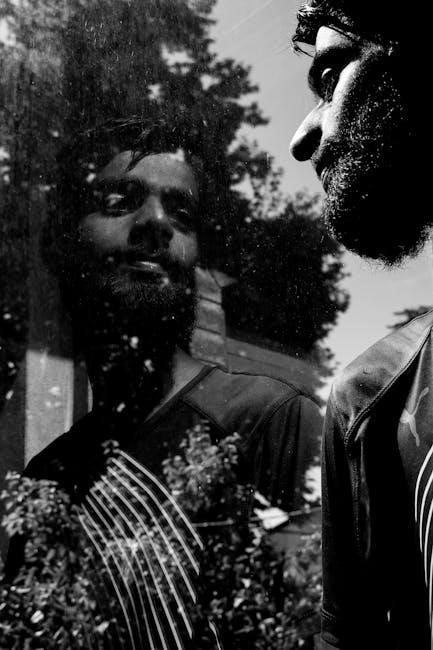The looking-glass self theory, introduced by Charles Horton Cooley, explains how individuals develop their self-concept based on others’ perceptions. It highlights the role of social interactions in shaping identity.
1.1 Definition and Overview
The looking-glass self theory, coined by Charles Horton Cooley in 1902, defines how individuals develop their self-concept by imagining and interpreting others’ perceptions of them. It suggests that self-awareness emerges through social interactions, where people act as mirrors reflecting judgments and opinions. This concept emphasizes the interplay between societal feedback and personal identity, shaping how individuals perceive their worth, values, and behavior. Cooley’s metaphor of the “looking glass” highlights the reflective nature of self-development in a social context.
1.2 Historical Context and Charles Horton Cooley’s Contribution
Charles Horton Cooley introduced the looking-glass self theory in 1902, as part of his work Human Nature and the Social Order. This concept emerged during a period of growing interest in social psychology and the study of identity formation. Cooley’s theory emphasized the role of social interactions in shaping self-perception, using the metaphor of a “looking glass” to describe how individuals reflect on others’ imagined judgments. His work laid the foundation for understanding the interplay between society and self, influencing later sociological and psychological theories.
The Three-Step Process of the Looking Glass Self
The theory outlines a three-step process: imagining how others perceive us, judging ourselves based on these perceptions, and developing self-feeling from these imagined judgments.
2.1 Imagining How Others Perceive Us
The first step involves imagining how others perceive us, using social interactions as a mirror to reflect our self-concept. Cooley’s metaphor suggests individuals envision others’ opinions, creating a mental image of how they appear to others. This imagination is often influenced by social cues, such as facial expressions, body language, and verbal feedback. While these perceptions may not always be accurate, they form the foundation for understanding oneself through the lens of others. This step emphasizes the role of societal reflection in shaping self-awareness and identity formation.
2.2 Judging Ourselves Based on Others’ Perceived Views
The second step involves judging oneself based on the imagined perceptions of others. Individuals evaluate their appearance, behavior, and worth through the lens of what they believe others think. These judgments often lead to feelings of pride or shame, shaping self-esteem. Cooley emphasized that these evaluations are deeply influenced by societal expectations and the imagined opinions of others. This step highlights how external perceptions are internalized, forming a critical component of self-concept and behavior alignment with social norms and values.
2.3 Developing Self-Feeling Based on These Judgments
The final step involves developing self-feeling, where individuals internalize the imagined judgments of others. This process shapes emotional responses, such as pride or shame, influencing self-esteem. Cooley argued that these feelings are central to forming a stable self-concept. The internalization of perceived societal opinions creates a sense of identity, guiding behavior and aligning it with social expectations. This step underscores how external perceptions become integral to personal identity and emotional well-being.

The Impact of Social Media on the Looking Glass Self
Social media amplifies the looking-glass self by providing platforms where individuals constantly seek validation and shape their identities based on likes, comments, and online interactions.
3.1 How Social Media Shapes Self-Perception
Social media significantly influences self-perception by creating a digital mirror where individuals imagine how others view them. Platforms foster constant validation through likes, comments, and shares, reinforcing or challenging self-images. Algorithms and echo chambers amplify certain perceptions, shaping identity formation. This digital feedback loop intensifies the looking-glass self, as people increasingly rely on online interactions to define their worth and behavior, blurring the line between authentic self-expression and curated digital personas.
3.2 The Role of Online Interactions in Modern Identity Formation
Online interactions profoundly shape modern identity formation by providing constant feedback loops. Social media platforms act as mirrors, reflecting how others perceive us. Personalization algorithms and echo chambers amplify specific identities, reinforcing self-concepts. These digital interactions often replace traditional face-to-face exchanges, creating a digital self that influences real-world behavior. The looking-glass self theory underscores how online validation and social feedback construct and refine personal identities in contemporary society, making digital interactions a cornerstone of modern self-formation.
Applications of the Looking Glass Self Theory
The theory aids in understanding consumer behavior, branding, and social psychology, offering insights into how individuals form preferences and identities based on perceived societal views and interactions.
4.1 Understanding Consumer Behavior and Brand Preferences
The looking-glass self theory helps explain how consumers develop preferences by imagining how others view their choices. Brands leverage this by creating personalized experiences, as individuals often align their preferences with perceived societal approval. This theory also highlights how social interactions and online reviews shape purchasing decisions, as people seek validation through others’ opinions. Companies use this insight to craft marketing strategies that resonate with consumers’ desire for social acceptance, ultimately influencing brand loyalty and identity formation in the marketplace.

4.2 Implications for Social Psychology and Sociology
The looking-glass self theory offers profound insights into social psychology and sociology by emphasizing how social interactions shape identity. It explains how individuals internalize societal norms and expectations, influencing their self-concept. This theory bridges psychology and sociology by highlighting the interplay between personal identity and social structures. It also underscores the importance of understanding how group dynamics and social norms influence behavior, making it a foundational concept for studying human interaction and societal influences on individual development.

Criticisms and Limitations of the Theory
The theory is criticized for overemphasizing social interactions and neglecting biological or individual factors in self-development. It also overlooks personal agency and internal drives.
5.1 Overemphasis on Social Interactions
The theory has been criticized for its heavy focus on social interactions, potentially overlooking the role of personal agency and internal drives in shaping self-concept. While it emphasizes how others’ perceived judgments influence identity, it may neglect biological and individual factors that also contribute to self-development. This overemphasis on external validation can lead to an incomplete understanding of how individuals form their sense of self, as it minimizes the impact of personal experiences and intrinsic motivations.
5.2 Lack of Consideration for Biological and Individual Factors
Critics argue that the looking-glass self theory neglects the role of biological and individual factors in shaping self-concept. While it focuses on social interactions, it often overlooks personal experiences, genetic predispositions, and internal drives that influence identity. This limitation means the theory may not fully capture the complexity of self-development, as it prioritizes external perceptions over intrinsic factors. Modern psychological theories have sought to address this gap by integrating both social and biological influences on self-concept.

The Modern Relevance of the Looking Glass Self
The theory remains highly relevant in understanding identity formation in digital spaces. Social media amplifies the process, with personalization algorithms and echo chambers shaping self-perceptions dynamically.
6.1 The Role of Personalization Algorithms and Echo Chambers
Personalization algorithms and echo chambers significantly influence self-perception by curating content that aligns with users’ existing beliefs. This creates a tailored online environment where individuals are repeatedly exposed to similar viewpoints, reinforcing their self-image. Eli Pariser’s concept of the “filter bubble” highlights how these algorithms narrow perspectives, impacting identity formation. In the context of the looking glass self, social media platforms amplify the process, as users base their self-concept on the reflections of their online interactions, often within these controlled ecosystems.
6.2 The Theory’s Application in Understanding Online Behavior
The looking-glass self theory offers insights into online behavior by highlighting how individuals shape their identities through digital interactions. Social media platforms serve as modern “mirrors,” where users imagine and interpret others’ perceptions of their online personas. This process accelerates due to instant feedback mechanisms like likes, comments, and shares. The theory helps explain how online communities and digital exchanges influence self-concept, making it a valuable framework for studying identity formation and behavior in the digital age.

The looking-glass self theory, formulated by Charles Horton Cooley, remains a timeless framework for understanding identity formation through social interactions and perceived judgments, influencing modern sociology.
7.1 Summary of Key Concepts
The looking-glass self theory, introduced by Charles Horton Cooley in 1902, suggests that individuals develop their self-concept through perceived societal judgments. It outlines a three-step process: imagining how others perceive us, judging ourselves based on these perceptions, and forming self-feelings accordingly. This theory emphasizes the role of social interactions and external validation in shaping identity. Cooley’s work remains influential, offering insights into how societal feedback influences self-perception and behavior, making it a foundational concept in sociology and social psychology;
7.2 The Enduring Influence of Cooley’s Theory in Contemporary Sociology
Cooley’s looking-glass self theory remains a cornerstone in contemporary sociology, offering insights into how identity formation is shaped by social interactions. Its relevance endures as modern sociology explores self-perception in digital spaces, such as social media. The theory’s emphasis on external validation aligns with studies of online behavior, personalization algorithms, and echo chambers. Cooley’s work continues to inspire research into how societal feedback influences self-concept, ensuring its lasting impact on understanding human behavior and identity in evolving social contexts.